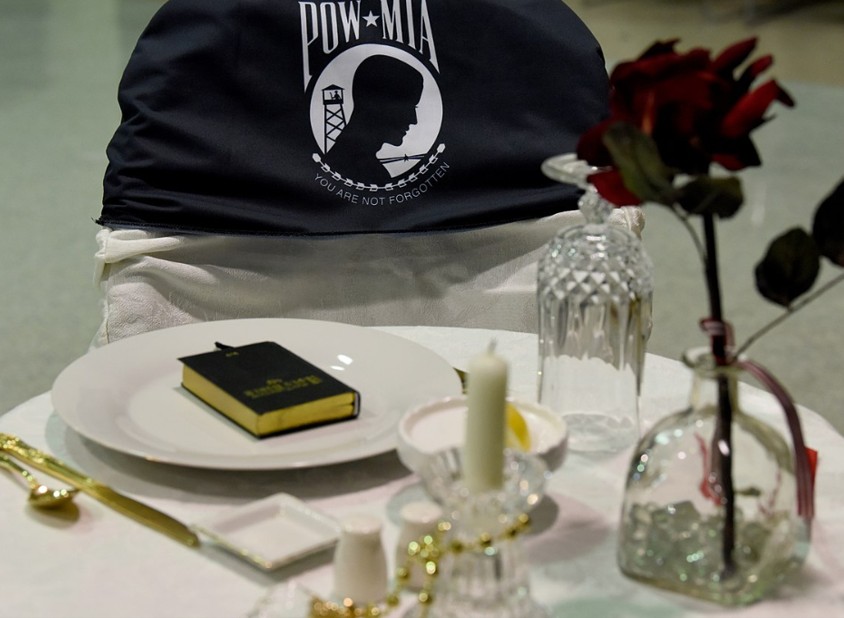
There are two consistent parts of military reunions. The first is the hospitality space. It is the heartbeat of the reunion. It is the place attendees go to relax, reminisce, and reconnect. The second is the banquet. They are traditionally held on the last night and are typically more formal than other meals held during the reunion. The specifics of a banquet can vary depending on the size of the reunion, and the preferences of the attendees. What happens during the banquet and why are they such an important part of the military reunion? Let’s break it down.

The banquet often begins with a welcome reception, allowing attendees to mingle. A photographer may be on hand for individual and group pictures. As the reception winds down, attendees take their seats. There is an opening ceremony that includes the presentation of colors, the Pledge of Allegiance, the singing of the national anthem, and an invocation. Many reunions will also include a presentation of the Missing Man Table. It is a solemn and important part of the banquet. The table is set with a white tablecloth, a single chair, a red rose in a vase, a plate with a lemon slice, a pinch of salt, and an inverted glass. It is not uncommon to see a Bible and an American Flag on the table as well. Each item has a symbolic meaning. A narrator explains their significance and the meaning behind them. Some presentations include the lighting of a ceremonial candle, often referred to as the “Candle of Hope.” The candle is usually lit during the presentation and extinguished at the end. After the narration, there is a moment of silence to honor and remember those who were prisoners of war and those who remain missing in action. This is a time for reflection and remembrance. The presentation of the Missing Man Table is often followed by a remembrance of those who have passed away since the last reunion.
Entertainment for the evening will vary for every reunion. There may be dancing to live music or a DJ. There may be guest speakers such as veterans, military leaders, or other notable figures who share inspirational stories, insights, or messages of appreciation. The banquet master of ceremonies may present special certificates or awards to veterans or active-duty service members in recognition of their service, achievements, or contributions. There may be a presentation of Vietnam War Veteran pins to those that served any time between November of 1955 and May of 1975. A slideshow or video presentation may be shown, featuring photos and videos from attendees’ military service or past reunions. This can be a nostalgic and emotional part of the event. Some reunions incorporate fundraising activities like raffles or silent auctions to support the reunion association or veterans’ charities. Military reunion banquets are an important part of the reunion for several reasons. During active duty, there was purpose, mission, connection, and belonging. Veterans often comment on the feeling of deep connection with fellow service members that transcends time. When they leave the military, these connections may be lost. The reunion banquet provides a sense of reconnection and belonging among attendees. These gatherings offer a unique and powerful form of support and camaraderie that is deeply meaningful to those who have served in the armed forces.
Here are a few things to consider when planning the banquet.
1. Establish a Banquet Planning Committee: This is different than the overall reunion committee. Having a banquet committee to deal with the details of the theme, decorations, speakers, photographers, and other entertainment allows reunion planners a chance to relax and enjoy the evening stress free. It reduces the workload for the reunion planner and provides an opportunity for more attendees to get involved.
2. Set a budget for the Banquet: Determine a budget for the banquet. Consider all expenses, including venue rental, catering, decorations, entertainment, audio visual, and any other related costs.
3. Plan the Program: Develop a program for the evening that includes speeches, presentations, and entertainment. Plot a timeline in 15-minute or 30-minute blocks to create the flow of the evening. Consider what time the room should be set and ready. What time do attendees arrive for the cocktail reception? Is there a set time to take a group photograph? How long with dinner service take? What will the evening speaker need for their presentation? If you have live music, what time should they set up so not to distract from other parts of the evening program. Will you have a stage and screen? Will presenters need audio visual support? Will you have a Missing Man table and when should it be set up?
4. Menu: Work with the catering team to create a menu that supports not only the reunion budget but also those with dietary restrictions. Be aware of the benefits and challenges of selecting a plated option and choice of entree versus a buffet. Determine how long you would like the cocktail reception bar to remain open and available. You might consider incorporating military-themed dishes or drinks to add to the atmosphere. Ask the catering team to create a special reunion themed beverage.

5. Décor and Centerpieces: Decorate the venue in a way that pays homage to the military. You can use flags, military memorabilia, and patriotic colors to set the tone. Inquire with the venue about any policies on décor and centerpieces. Candles may be restricted or limited to only a small votive option. Make sure centerpieces do not obstruct the view of guests sitting across the table from each other.
6. Guest List and RSVPs: Work with the reunion planner to maintain a guest list and track RSVPs to ensure you have an accurate count of attendees. You should also keep track of their preferred entree selection, ie beef or chicken, if the plan is to have an entree option. This will help with catering, room set up, and seating arrangements.
Remember that the key to a successful military reunion banquet is attention to detail and thoughtful planning. By creating a memorable and meaningful experience, you can honor the service and sacrifices of military personnel and their families.
Visit MRN Speakers Bureau – The Military Reunion Network for ideas for speakers for your next reunion
